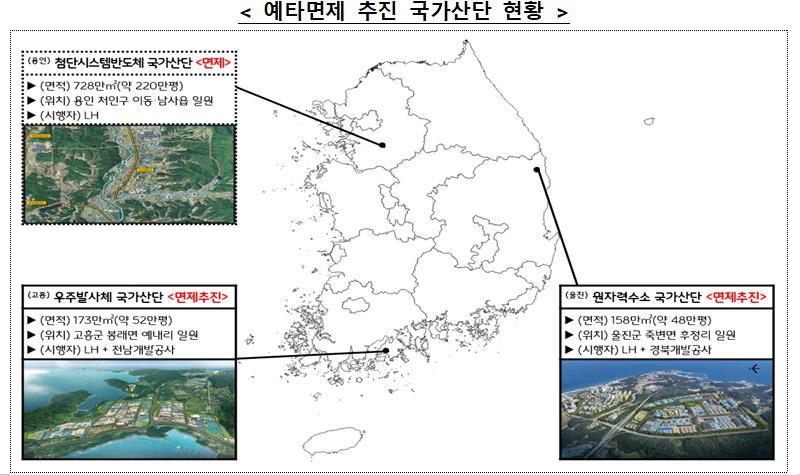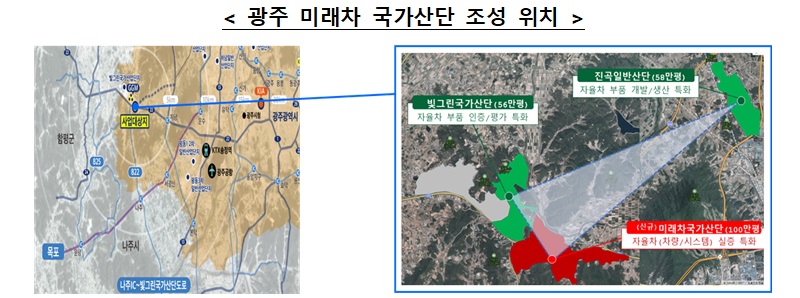Ministry of Strategy and Finance announces customized support plan for high-tech industry clusters… Shortened pre-trial period by 3 months
The government is seeking exemption from the preliminary feasibility study (pre-feasibility study) for the Goheung Space Launch Vehicle National High-Tech Industrial Complex (National Industrial Complex) in Jeollanam-do and the Uljin Nuclear Hydrogen National Industrial Complex in Gyeongbuk. The purpose is to use this as a driving force to accelerate the creation of a national industrial complex.
In addition, among natural green areas, the building-to-land ratio and floor area ratio of education, research, and commercialization facility areas will be increased, and measures to relax the requirements for lifting development restriction zones for the Gwangju Future Automobile National Industrial Complex site will also be reviewed.
The Ministry of Strategy and Finance announced a ‘customized support plan for high-tech industry clusters’ containing these contents at the Emergency Economic Ministers’ Meeting held on the 14th. This is because it is judged that there is a need to quickly create designated high-tech industry clusters and focus support policies in order to respond to the intensifying competition in the global high-tech industry.
◆Goheung and Uljin industrial complexes are exempted from preliminary testing
The government will first pursue a plan to exempt industrial complexes in Goheung, South Jeolla Province, and Uljin, North Gyeongsang Province, which have sufficient corporate demand and a large economic impact, from preliminary tariffs.

Currently, Yongin, Gyeonggi Province, which has been designated as a semiconductor high-tech national industrial complex, is establishing an industrial complex plan after being exempted from preliminary taxation. For the remaining 14 industrial complexes, business feasibility studies are in progress.
The government plans to select 14 industrial complexes as projects subject to public pre-tat from time to time and support the rapid creation of industrial complexes by shortening the pre-tat period from the current seven months to three months.
It was decided to review ways to make the occupancy demand standards for industrial complexes more realistic by taking into account the characteristics of the industry and region. For non-metropolitan industrial complexes, the company size standard that reflects occupancy demand is relaxed to 200 or more employees through business agreements.
It was decided to increase the building-to-land ratio and floor area ratio of the special research and development zone. In special research and development zones, the need to expand space for new technology research and start-up/commercialization is increasing due to the concentration of science and technology-funded research institutes. However, there are restrictions on expanding research space and attracting investment in ventures and startups due to restrictions on building-to-land ratio and floor area ratio for natural green areas.
The government plans to support securing space by raising the building-to-land ratio and floor area ratio of education, research, and commercial facility areas among natural green areas through deliberation by the Urban Planning Committee.
Accordingly, education, research, and commercialization facility areas located in natural green areas will be able to increase their building-to-land ratio and floor area ratio without an upper limit within the 7th floor.
The total amount of pollution is first allocated to development plans that guarantee water quality improvement. The water pollution cap system is a system that requires development within the pollution discharge quota granted every 10 years. Long-term development projects can first receive an allowance within 60% of the current allowance for the next 10 years.
The government has decided to pursue a plan to not apply the next stage allocation cap (60% of the current stage) for large-scale projects where water quality improvement is guaranteed.
The complex of land available for occupancy, including commercial, cultural, and convenience facilities, within the cluster will be expanded.
The introduction of new mixed-use land within the industrial complex is permitted without changing the development plan, and a portion of the research facility site within the Osong High-Tech Medical Complex is changed to mixed-use land.
In order to ease the management burden on Korea Land and Housing Corporation (LH), which is participating in the national industrial complex candidate site, we will review ways to consider costs and losses related to the creation of a national industrial complex when evaluating management.
Investment uncertainty is also resolved by providing guidelines for concluding basic agreements between LH and local governments.
◆Customized support for each complex
We are also working to resolve difficulties in each industrial complex. The Pyeongtaek area, where working conditions are poor due to traffic congestion caused by large-scale development, is seeking to improve the transportation network to access the southern industrial complex.
In order to expedite the construction of the 3rd Pangyo Techno Valley, standards for applying the public institution architectural design contest obligation were also presented. If a private business becomes the subject of design, etc. by sharing the burden, it does not have to be obligated.
Songdo ‘K-Bio Lab Hub’ will shorten the total project cost consultation period and design adequacy review period.
The Anseong Semiconductor Materials and Materials Complex specializes in predicting electricity demand in accordance with the completion date of the industrial complex and reviewing power supply plans, such as building a new substation. If it is necessary to build new power facilities, related organizations such as the Ministry of Trade, Industry and Energy, local governments, and KEPCO will collaborate to reinforce transmission lines.
In the case of the Daejeon Nano/Semiconductor Industrial Complex, a business plan will be prepared excluding the Honam Expressway branch line expansion area. The purpose is to quickly build an industrial complex by promoting a rapid preliminary application.
For Cheonan and Asan display specialized complexes, vehicle operation permits for transporting large display equipment are supported.
Regarding the Ochang Secondary Battery Specialty Complex, if new construction or expansion of facilities has a small impact on the educational environment, a legal basis will be established for exemption from educational environment impact assessment.

The Gwangju Future Automobile National Industrial Complex and the Changwon Defense and Nuclear Power National Industrial Complex are considering easing the green belt release requirements. This is in response to criticism that there are restrictions on site use because the planned site is included in the greenbelt.
The Saemangeum secondary battery specialized complex will increase site utilization by relaxing the ecological area ratio standards. In addition, the plan is to reduce investment uncertainty for Saemangeum secondary battery companies by establishing guidelines for high-concentration salt treatment by secondary battery companies.
The Gwangju Future Automobile National Industrial Complex and the Changwon Defense and Nuclear Power National Industrial Complex are considering easing the green belt release requirements.
Ministry of Strategy and Finance
Source: Policy news, link


Comments